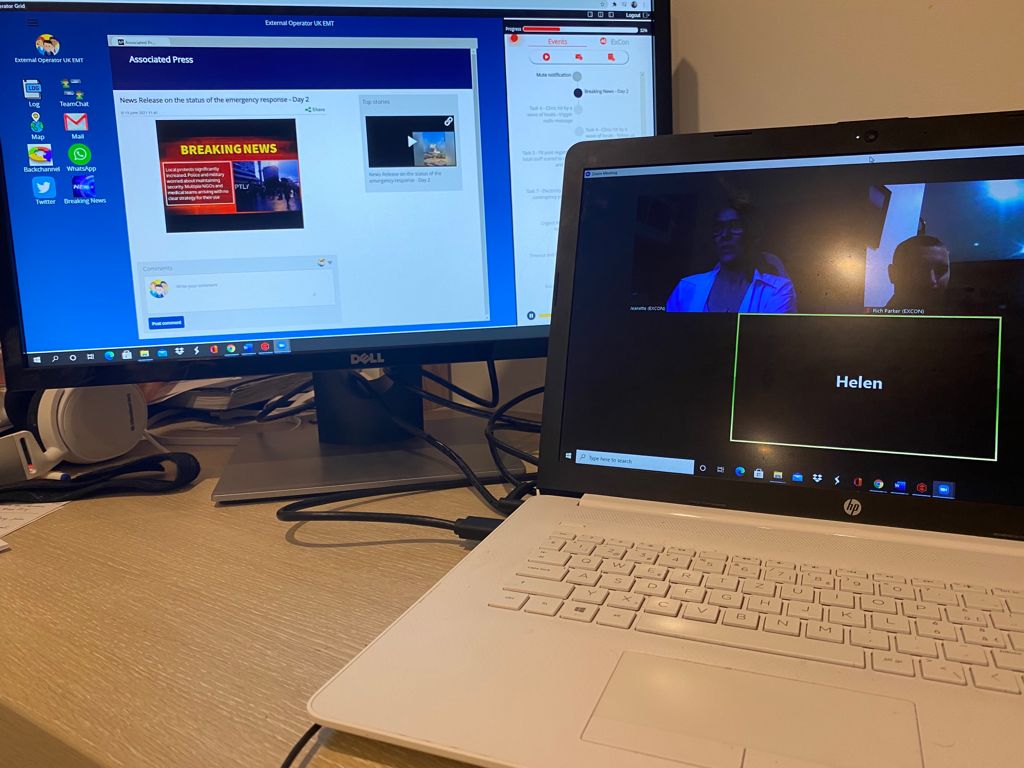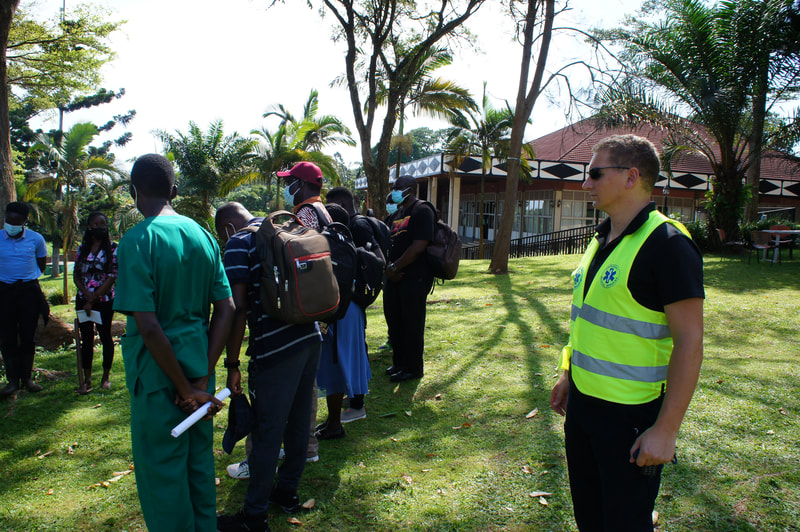By Jeanette Dyson
I became involved in the world of humanitarian and emergency response training in the summer of 2020; an unforeseen yet one of the welcome consequences of the Covid-19 pandemic.
Training In Aid (TIA) has a global reputation for providing world-leading emergency response and preparedness training that supports international humanitarian and emergency response organisations. Pre-pandemic, most of TIAs training was face-to-face. Participants and trainers would travel from around the world to a central location to benefit from TIA’s experiential training courses that are proven to facilitate and expedite learning.
Then the world shut down.
Training In Aid (TIA) has a global reputation for providing world-leading emergency response and preparedness training that supports international humanitarian and emergency response organisations. Pre-pandemic, most of TIAs training was face-to-face. Participants and trainers would travel from around the world to a central location to benefit from TIA’s experiential training courses that are proven to facilitate and expedite learning.
Then the world shut down.
As with many companies and organisations faced with closed borders and restrictions on gatherings and meetings, Training In Aid (TIA) had to adapt. And adapt quickly.
Within a couple of months, founder, Rich Parker, launched an online, virtual training exercise simulation platform known as REM-Systems (Remote Exercise Management Systems). This ground-breaking product provided experiential, and highly effective training for emergency response teams wherever they were in the world. All that was required was internet access. It enabled vital training to continue despite lockdown.
Within a couple of months, founder, Rich Parker, launched an online, virtual training exercise simulation platform known as REM-Systems (Remote Exercise Management Systems). This ground-breaking product provided experiential, and highly effective training for emergency response teams wherever they were in the world. All that was required was internet access. It enabled vital training to continue despite lockdown.
How I became involved
REM-Systems was unlike anything previously used by the emergency response training sector. Rich needed to get the message out quickly explaining what REM-Systems is, how it works and how organisations can benefit by maintaining their planned training programme. The main difference being it is by Zoom rather than face-to-face.
Rich and I have known each other for too many years to politely mention, but this was the first time our working lives had crossed. As my background is in PR, communications and copywriting, Rich reached out to me for help in promoting REM-Systems.
It was a meeting that introduced me to an entirely new world. Having created a suite of marketing materials for REM-Systems, Rich invited me to support the online training exercises. I took on new roles and had the opportunity to feel that I’d played some small part in preparing participants for deployment, by arming them with the public relations skills to work more effectively with the media.
Rich and I have known each other for too many years to politely mention, but this was the first time our working lives had crossed. As my background is in PR, communications and copywriting, Rich reached out to me for help in promoting REM-Systems.
It was a meeting that introduced me to an entirely new world. Having created a suite of marketing materials for REM-Systems, Rich invited me to support the online training exercises. I took on new roles and had the opportunity to feel that I’d played some small part in preparing participants for deployment, by arming them with the public relations skills to work more effectively with the media.
Virtual and face-to-face
In December 2021, I had the opportunity to work, via TIA, with the World Health Organisation in real life. It was in Uganda for one of the first face-to-face Team Member Induction and Training of Trainer courses run by the African Region Training Centre.
While online can never truly capture the additional benefits of the real-life experience of face-to-face training – with the networking, camaraderie and friendships that develop during breaks and downtime – my experience in Uganda demonstrated how close the online experience mirrored face-to-face training and simulation exercises.
Throughout my time working in the humanitarian and emergency response sector, one thing that has always amazed me is the breadth of skills that participants are equipped with during these relatively short courses.
Within the space of a few days, doctors, nurses, paramedics, firefighters, logistics, security and other specialists, are armed with the tools to be self-sufficient out in the field. Not only must a doctor know how to treat a patient, he or she must also know how to operate a field hospital; establish basic services such as clean water, safe food and sanitation; triage (often) multiple casualties who are seriously ill or wounded; know how to keep themselves and their colleagues and patients safe, and that’s just for starters.
Whether it’s online or face-to-face, the value of experiential training cannot be underestimated. While learning the theory is obviously necessary, it’s only when an individual’s skill and knowledge is tested in the field (albeit in the safe space of an experiential exercise) that the learning is truly embedded and changes in behaviour are seen. It was incredible to see just how effective experiential learning can be.
While online can never truly capture the additional benefits of the real-life experience of face-to-face training – with the networking, camaraderie and friendships that develop during breaks and downtime – my experience in Uganda demonstrated how close the online experience mirrored face-to-face training and simulation exercises.
Throughout my time working in the humanitarian and emergency response sector, one thing that has always amazed me is the breadth of skills that participants are equipped with during these relatively short courses.
Within the space of a few days, doctors, nurses, paramedics, firefighters, logistics, security and other specialists, are armed with the tools to be self-sufficient out in the field. Not only must a doctor know how to treat a patient, he or she must also know how to operate a field hospital; establish basic services such as clean water, safe food and sanitation; triage (often) multiple casualties who are seriously ill or wounded; know how to keep themselves and their colleagues and patients safe, and that’s just for starters.
Whether it’s online or face-to-face, the value of experiential training cannot be underestimated. While learning the theory is obviously necessary, it’s only when an individual’s skill and knowledge is tested in the field (albeit in the safe space of an experiential exercise) that the learning is truly embedded and changes in behaviour are seen. It was incredible to see just how effective experiential learning can be.
Farewell for now
Recently, I was given a new opportunity to evolve my skills in the digital world. As a result, my career is changing direction for now. However, I sincerely hope that Rich’s words to me are true (which I have no reason to doubt). He said:
“Once you’ve been part of the humanitarian world, you’re always a part of the humanitarian world.”
I’ve met and had the opportunity to work with some amazing people from literally every corner of the world. While some time zones were more amenable than others, I’ve thoroughly enjoyed every minute of my time working with TIA and their various partners. Thank you all for generously welcoming me with open arms.
It’s truly awe-inspiring to know that there are so many people willing to go to whatever lengths necessary to provide medical and emergency aid to help to people when they need it most.
For now, it’s au revoir rather than goodbye, and I hope to see you all again soon.
“Once you’ve been part of the humanitarian world, you’re always a part of the humanitarian world.”
I’ve met and had the opportunity to work with some amazing people from literally every corner of the world. While some time zones were more amenable than others, I’ve thoroughly enjoyed every minute of my time working with TIA and their various partners. Thank you all for generously welcoming me with open arms.
It’s truly awe-inspiring to know that there are so many people willing to go to whatever lengths necessary to provide medical and emergency aid to help to people when they need it most.
For now, it’s au revoir rather than goodbye, and I hope to see you all again soon.



 RSS Feed
RSS Feed